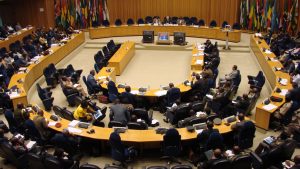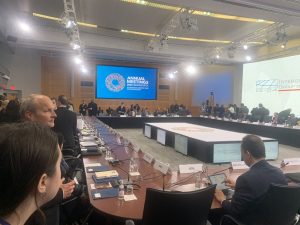Consultant – Endline Evaluation (OFDA) at Save the Children Nigeria

Save the Children is the leading independent organization for children in need, with programs in over 120 countries. We save children’s lives. We fight for their rights. We help them fulfil their potential. Save the Children is working in Nigeria because one in five children in Nigeria dies before their fifth birthday. About 40% of children miss out on school and have to work to survive while nearly 2 million children have lost one or both parents to an AIDS-related disease.
We are recruiting to fill the position below:
Job Title: Endline Evaluation for The Emergency Nutrition, WASH, And Protection Response For Conflict-Affected Populations In Northeast Nigeria (OFDA) Consultant
Job ID: 200002XB
Location: Maiduguri, Borno
Employee Status: Fixed Term
Background
- Save the Children has been working in Nigeria since 2001 and is currently working in 20 states focusing on child survival, education and protecting children in both development and humanitarian contexts. The conflict in Northeast Nigeria has left 8.5 million in need of humanitarian assistance (HRP 2017), in particular the more than 1.8 million IDPs. Over half of the displaced are children (55%), half of whom are under five years old. Borno state has been the most affected and is host to nearly 1.4 M IDPs (IOM).
- The conflict has resulted in alarming rates of malnutrition with high global acute malnutrition (GAM) and Severe Acute Malnutrition (SAM) rates, many of which exceed WHO emergency threshold levels of 15% and 2% respectively. Of the 398,188 children suffering from SAM, less than one third (only 114,097 children) have received treatment. A lack of adequate water and sanitation infrastructure along with poor Infant & Young Child Feeding (IYCF) and hygiene practices are increasing malnutrition and stunting
Key results of the project include:
- To increase access to life-saving treatment services for children under 5 with SAM, while promoting appropriate IYCF-E practices that optimize nutrition and health survival outcomes
- Children and families affected by conflict have improved access to safe, adequate and quality water, sanitation services and improve hygiene practices towards reducing sicknesses and ensuring better health
- To create safe spaces for children and build capacity of key humanitarian workers and community members on psychosocial support.
Purpose
- This endline evaluation will be conducted in the implementation areas and communities of Jere, Magumeri, Mafa, Konduga and Kaga LGAs. This endline will be compared against the baseline results which focused on the knowledge attitude and practices (KAP) of communities across the 3 sectors that the OFDA project targeted.
The specific objectives of the study are to:
- Generate data for a set of indicators outlined in project M&E plan;
- Use collected data as benchmark for measuring project success or failure;
- Compare the current status of the context with what was present prior to project implementation
- Suggest priority areas for future programming
The endline study will include the following criteria:
- Nutrition: What are the current nutrition outcomes in each of the proposed communities compared to a year ago when the project started? How knowledgeable are the community members on nutrition outcomes (EBF, complementary feeding)? Has there been a change in practices/ behaviour? Additionally, the study will ascertain the state of the health facility listed for OTP. Specifically, the facilities will be assessed for space (waiting area), toilet facilities, availability of staff and general organization.
- Child Protection: This will be limited to assessing knowledge/practice of child protection among adults. Specifically, this section will focus on knowledge on child discipline and awareness of protection concerns in the communities. The results of this will be compared against the baseline study to ascertain what has changed.
- WASH: To what extent are the community members aware of the key practice and knowledge of WASH? The WASH component will also involve observation walks by enumerators. Observation walks will be conducted around WASH hardware in the selected communities as well the general functioning-status of this hardware including walking from the water hardware to the nearest households.
- Challenges: Based on the evidence from the study, what are the challenges recorded during project implementation and how can this be remedied against possible future projects.
- Recommendation: Actionable recommendation based on the evidence and data collected during fieldwork to inform implementation strategies across the sectors (Wash, Nutrition and Child Protection).
Evaluation criteria and key questions:
- Evaluation study will explore the following key areas and questions based on the most relevant of the OECD-DAC and CHS criteria for evaluating humanitarian action and some additional areas which SCI would like to explore in depth:
Relevance/Appropriateness:
- To what extent the interventions address the needs of beneficiaries?
- Were the activities/outputs aligned with the needs of the affected community during the design phase of the project??
- Were the interventions per sector planned and implemented in an integrated manner?
- Was communication and coordination between sectors regarding implementation well aligned?
- Are there overlaps of interventions in sectors (geographical or beneficiaries)? what is the outcomes of the integrated programming when compared to the non-integrated?
- What is the impact of the integrated programming with reference to OFDA.
Coverage, and non-discrimination:
- Did the project reach to the most vulnerable children affected by the crisis and with specific needs as targeted by the project? Did the project reach out to children at risk of exclusion from service provision as identified in the baseline study? If so, how? was the intervention accountable to affected population? If so how?
- How sensitive was the programme interventions to address the inequalities due to gender, race and age?
Effectiveness:
- Were the activities implemented as planned, achieving intended outcomes and objectives within the planned budget and timeline?
- What were the key underlying factors influencing the achievement or non-achievement of specific objective and overall goal of the project?
- How effective was the project intervention in addressing key bottlenecks to ensure access to interventions to treat SAM cases?
- Document effective approaches which influenced community behavior to improve malnutrition status of children.
- How effective were the interventions to address the inequality in SAM treatment based on gender, income and social status?
- How effective was the project intervention in addressing exclusive breastfeeding and minimum diet diversity?
- How effective were Child Protection Committees (CPCs) in identifying and appropriately referring child protection cases? What barriers to their effectiveness have been addressed and which ones still exist? Once referred did Save the Children adequately follow up to make sure child protection cases were appropriately addressed.
- How effective were Child Friendly Spaces (CFS) in providing inclusive (age/ gender/disability), sensitive and culturally appropriate activities as well as psychosocial support and referral services?
- Did the intervention cause a change in the lives of the affected population vis-à-vis the project objectives?
More specifically, the endline on the following list of indicators:
- % of respondents who know 3 of 5 critical times to wash hands
- Percentage of girls and boys 0-<6 mo. who are exclusively breastfed
- Percentage of children 6-<24 months of age who receive foods daily from 4 or more food groups (to achieve minimum dietary diversity)
- Proportion of breastfed and non-breastfed children 6–23 months of age who receive solid, semi-solid, or soft foods (but also including milk feeds for non-breastfed children) the mini-mum number of times or more.
- Proportion of children 6–23 months of age who receive a minimum acceptable diet (apart from breast milk).
- Initial number of functional water points in the communities (prior to project implementation)
- % of parents/caregivers who use physical punishment as a means of discipline
- % of caregivers who state they would report a suspected case of child abuse
Key protection concerns in the communities
Child outcomes:
- Was there a sufficient child-focus in the project design and implementation?
- Were the intended outcomes of this project specifically for children met?
- Were any unintended child outcomes observed from cash transfer and other FSL/NFI/shelter activities under this project (e.g increase in school attendance; preventing children from being placed in institutions; reduction of the stress caregivers feel in meeting survival needs; reduction of the physical and verbal punishment of children; decreasing stress in children; improvements in children’s wellbeing)
Accountability:
- How were the communities engaged in the whole project cycle? Did the project encourage the genuine and active participation of children and communities?
- How accountable has the implementation been in terms of addressing the needs of children and their families?
- What was the level of adaptive programming that resulted from the accountability data?
- How effective is the accountability mechanisms set in place during implementation? Was the project resolved identified or perceived issues, conflicts, or complaints in the community through the mechanisms?
Efficiency:
- Were the project activities are cost-effective?
Impact:
- What are the key short term and long term changes produced by project, positive or negative and what are the key factors behind these changes?
- What are the key intermediate and lasting changes lead by the project interventions?
- Were there any unintended results of the intervention and how did it affect the outcomes?
Sustainability:
- To what extent will the benefits of the projects continue after the funding ceases?
- What will be the structures at community level and health facility level to identify, screen and treat malnutrition once the project is over?
- Which of the structures at the community level to identify protection issues are the most sustainable and why? Will the CPCs be continue their activities after the project?
- Has there been an exit strategy that has been well implemented?
Lessons Learned:
- What were the good practices and challenges in the project? How did it able to affect implementation and project delivery?
- Were the recommendations from the baseline taken into consideration in the implementation on the project?
Evaluation Design and Methodology:
- The consultant will develop a mix of qualitative and quantitative data collection. The quantitative data will be collected using questionnaires as deployed through Kobo Toolbox while health facility assessment data will be collected using the dedicated OTP/SC facility assessment tool. The methodology will be presented as part of the draft work plan as outlined in the deliverables below and included in the final report. As this study is a endline evaluation, there will be reviews of internal document such as project proposal documents, baseline report, progress reports and project data, including the MEAL plan and more.
The following guidance should be considered:
- There should be meaningful and safe participation of children and young people, ensuring ethical standards for research with children are followed, including informed consent and assent, ensuring the best interest of the child, confidentiality and avoiding harm, which is aligned with SC’s Child Safeguarding Policy.
- Focus group discussions, key informant interviews, and lessons learned and validation workshops are required.
The following data analysis is expected for the consultant to deliver:
Baseline vs. Endline:
- Evaluation Results vis-à-vis the ToR questions
- Evaluation Results vis-à-vis the logframe
- With gender and locale disaggregation
Profile and responsibilities of evaluator:
- Have experience and significant knowledge of humanitarian response mechanisms, specifically regarding the Northeast humanitarian response, and have previous experience in conducting external evaluations for conflict responses
- Minimum experience of 5 years in coordination, implementation, monitoring and evaluation of emergency response programmes AND expertise in at least 1 relevant sector (Food Security & Livelihoods, Nutrition, Child Protection)
- Demonstrated experience of evaluating humanitarian response projects is essential (experience of evaluating OFDA-funded projects is desirable)
- Knowledge and experience in child participatory approaches and child safeguarding
- Fluency in English and ability to write clear and concise reports (examples of previous work will be requested)
- Understanding of OFDA requirements as a humanitarian donor and specific requirements for this evaluation.
- Ability to manage the available time and resources and work to tight deadlines.
Deliverables
These deliverables are to be submitted to SCI in both electronic and hard copy, as described below:
- Inception report according to the standard template, including detailed work plan. Also, once TAs will review and sign off the inception report then consultant will start the data collection.
- With methodology, sample size calculation by indicators and proposed sampling technique. Draft evaluation tools (interview guides) for the evaluation for approval by SCI. Draft and final evaluation reports.
- The final report, which should not exceed 25 pages excluding annexes, should be written in English and will be shared with OFDA as well as other stakeholders. Standard reporting format will be shared with consultant.
- Complete Log frame with the actual achievements disaggregated (by gender and location).
- Time frame for this consultancy is 30 days
Application Closing Date
12th June, 2020.
The post Consultant – Endline Evaluation (OFDA) at Save the Children Nigeria appeared first on Jobs in Nigeria – http://jobsinnigeria.careers.







